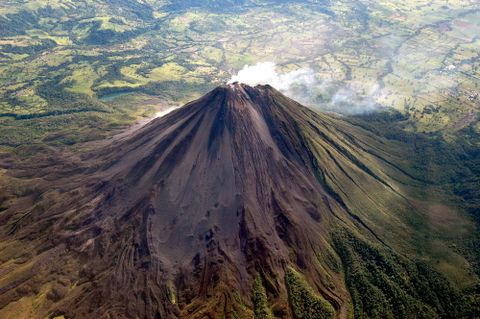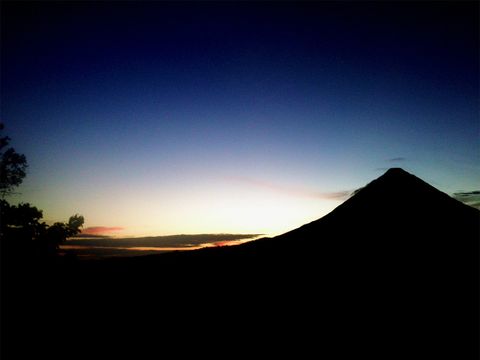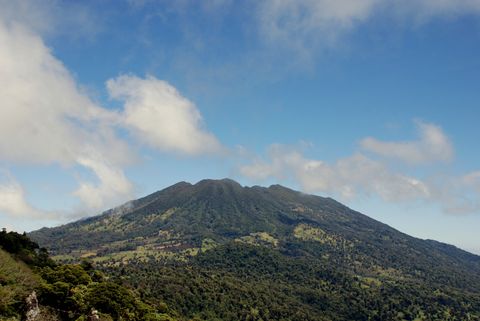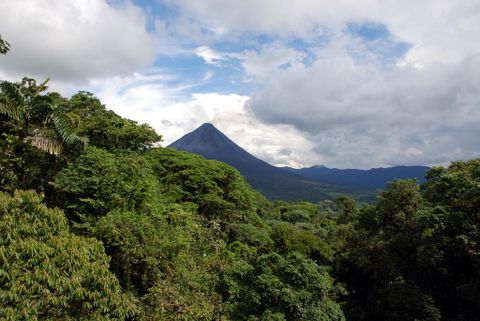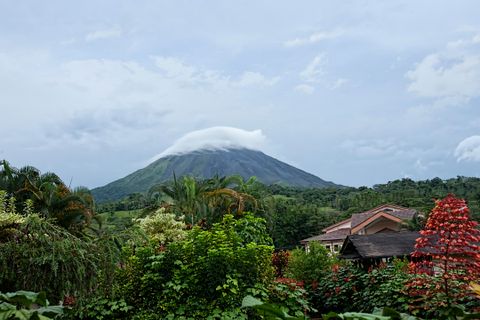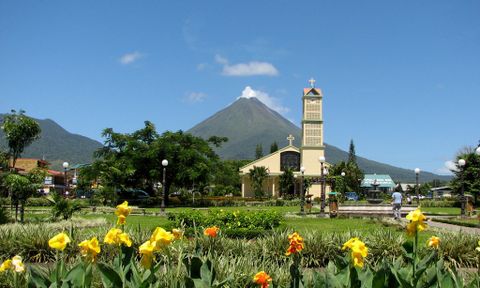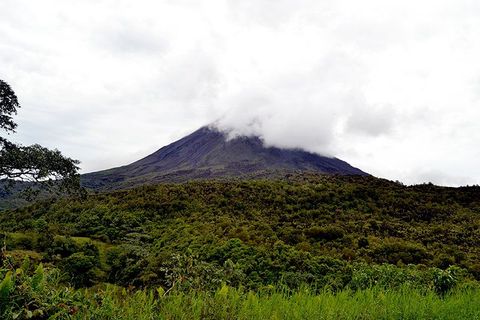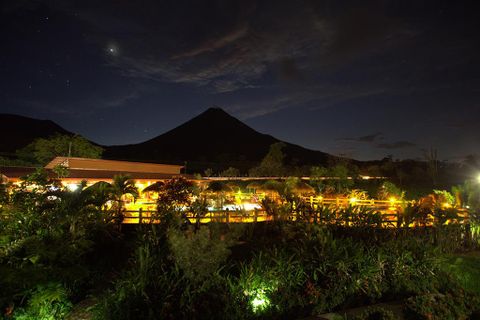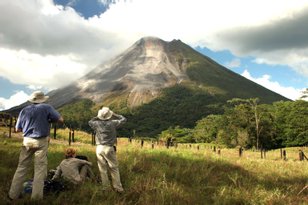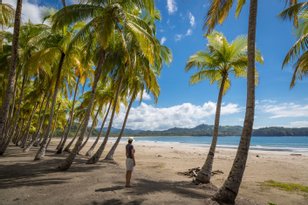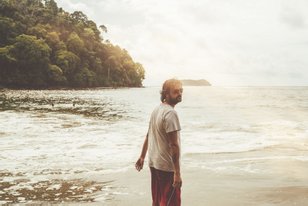Arenal Volcano Travel Guide
At 5,437 feet (1,657 meters), the Arenal Volcano looms large and ominous over the pastured green hillsides that surround its base. Although currently in a resting phase, Arenal remained the country’s most active volcano for the past 43 years. Its storied history is charged with eruptions — both major and minor — that have intimately affected the region and the people who live here.
The adventure and excitement you'll enjoy in today's Arenal was formed some 7,000 years ago from the adjacent (and now extinct) Chato Volcano, Arenal’s most recent eruptive period began in 1968 with an explosion that buried three small villages and left 87 people dead. Up until July 2010, the eruptions had been constant, though much less severe — there were effusions of smoke and lava on an almost daily basis.
Since 2010, however, the volcano’s seismicity, explosions and lava flows have decreased significantly. It is, scientists assure us, still alive; it’s just sleeping. At present, visitors will be unable to see lava flowing down its sides or find plumes of ash rising from its top. Still, there is much to see and do here — including rainforest hikes, whitewater rafting, horseback riding and many more amazing things to do during your visit to Arenal.
How to start planning your Arenal Visit?
- Visit the Arenal Volcano National Park
- La Fortuna village scenery, hotels, dining, and nightlife
- Lounge in hot springs heated by the volcano
- Hike and swim the 200-ft waterfall hike near town
- Largest lake in Costa Rica is here Lake Arenal
- Discover 100 things to do around Arenal
- Navigate the rocky terrain and enjoy volcano views
- Ask the local experts!
Video: Arenal Volcano
How the Arenal Volcano Volcano Works
Arenal is what is known as a stratovolcano – a tall, symmetrical volcano that’s built upon successive layers of rock, ash and lava. Due to the convergence of oceanic and continental tectonic plates, magma (the molten or partially molten rock that forms beneath earth’s surface) rises into Arenal’s volcanic chamber and can eventually erupt from its top.
Plate tectonics is the theory that Earth's outer layer is made up of plates, which have continued to move throughout Earth's storied history. The theory explains the dynamics of mountain formation, earthquakes and volcanoes. It also explains how similar animals came to live on what are now widely separated continents.
You probably wouldn't recognize the Earth if you could see it 225 million years ago. At that time, all of the major continents formed a giant supercontinent, called Pangaea. Around 200 million years ago, Pangaea began to rift and split apart. A buildup of heat underneath Pangea may have initiated this splitting. The ocean filled areas between the new sub-continents and the landmasses continued to move apart, riding on separate plates, until they reached the positions that they occupy today. The continents are, in fact, still on the move.
What drives plate tectonics is not precisely known. One theory is that convection within the Earth's mantle pushes the plates in much the same way that air, heated by your body, rises up and gets deflected by the ceiling. Another theory proposes that gravity pulls the colder and heavier ocean floor with more force than it pulls the newer and lighter seafloor, thereby enabling the top layers to drift apart.
Regardless of what drives the movement, plate tectonic activity takes place at four types of boundaries: divergent boundaries, where new crust is formed; convergent boundaries, where crust is consumed; collisional boundaries, where two land masses collide; and transform boundaries, where two plates slide against each other.
The size of the Earth has not changed significantly in the past 600 million years. In fact, it probably hasn't changed much since its formation some 4.6 billion years ago. As Harry Hess surmised, the Earth's unchanging size implies that its crust must be destroyed at about the same rate as it is created. Along the convergent boundaries, where crust is destroyed (recycled), the plates are moving toward each other. Sometimes one plate sinks (or becomes subducted) under the other. This plate sinking occurs along a location that is called the subduction zone.
If we could pull a plug and drain the Pacific Ocean, we would see an amazing sight: an ocean floor cut by narrow, curving trenches that run thousands of kilometers long and 8 to 10 km deep. These trenches are the deepest parts of the ocean and are created by the process of subduction.
At a depth between 190 and 430 miles (300 and 700 km), the rock of a descending plate starts to melt. Most of this molten ocean floor becomes part of the Earth's mantle, perhaps to reappear at a distant divergent boundary. However, some makes its way to the Earth's surface and produces volcanoes.
The type of convergence that occurs depends on the kind of lithosphere involved. Convergence can occur between an oceanic plate and a continental plate (as in the case of Costa Rica's Arenal Volcano), or it can occur between two oceanic plates or between two continental plates.
Continental plates, which are composed of less dense material, generally override oceanic plates. Magma, which is generated from the melting subduct plate, rises and squeezes into cracks. Eventually, it reaches the surface as a volcanic eruption.
Approximately 85% of stratovolcanoes are located around the Pacific Ocean, forming the so-called Ring of Fire. They occur at the convergent margins of tectonic plates, where large sections of Earth's crust are moving together and where one plate subducts.
Magma
Magma is the molten or partially molten rock that forms beneath the Earth's surface. Magma is a hot, silicate, carbonate, or sulphide melt that contains dissolved volatiles and suspended crystals. It is generated by a partial melting of the Earth's crust or mantle, and it forms raw material for all igneous processes supplying the volcano. When magma erupts onto the surface, it is called lava.
Magma rises from its source region, in the mantle or the lower crust, and enters a magma chamber. This portion of the volcano's "plumbing system" acts as a temporary storage reservoir, and it is usually situated beneath the summit of the volcano at depths of less than 5 km. From the magma chamber, magma may supply fresh material for eruptions by rising up a central "chimney," referred to as the volcanic conduit or pipe. The magma of the Arenal Volcano contains high levels of water and other chemicals, making it highly explosive, like the Stromboli Volcano in Italy.
